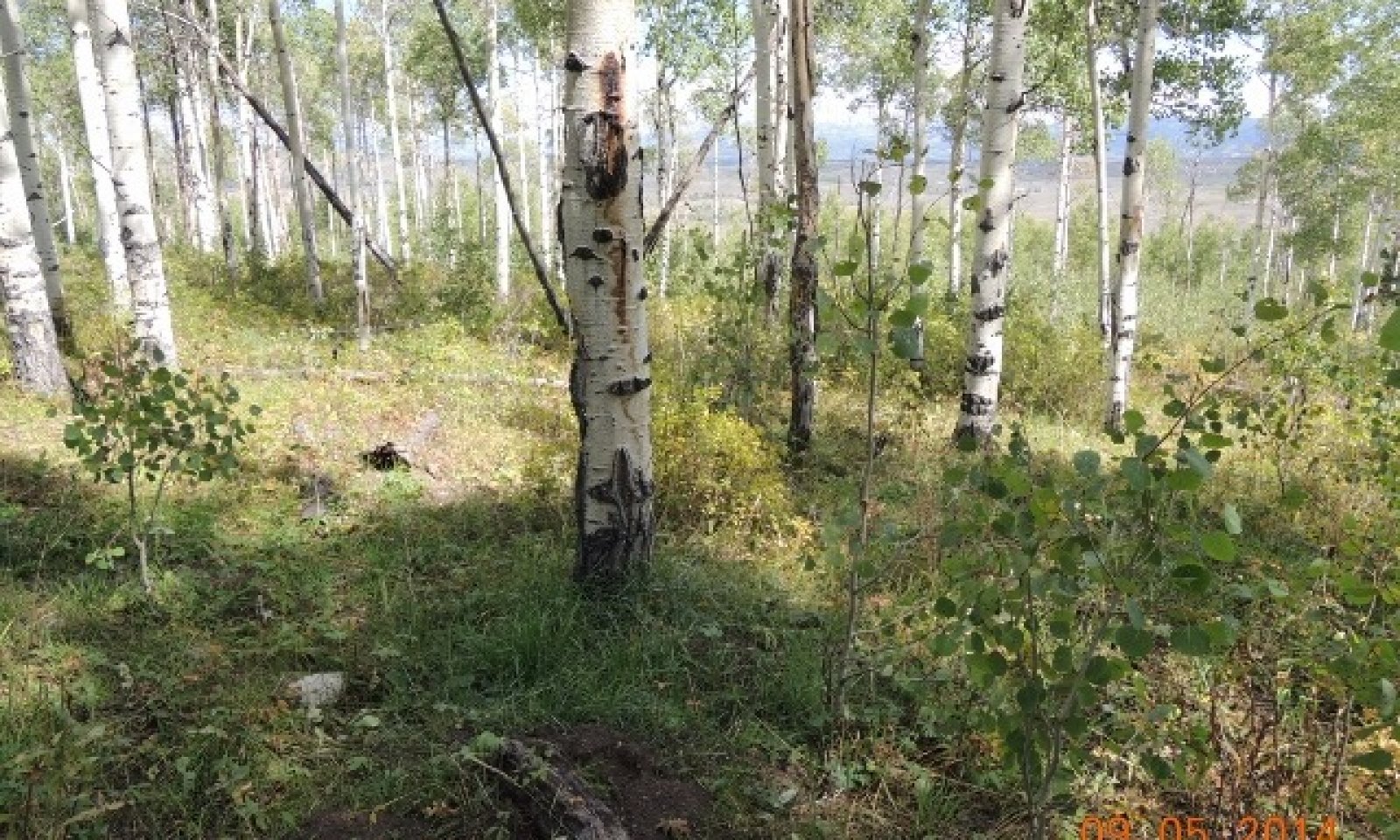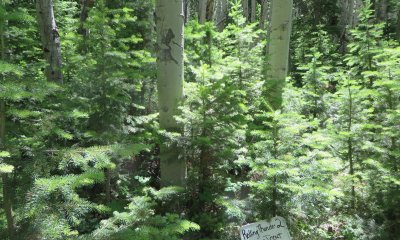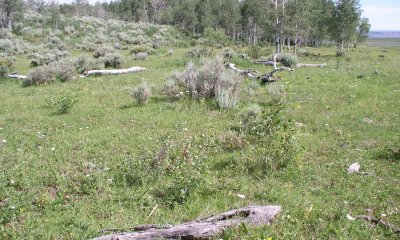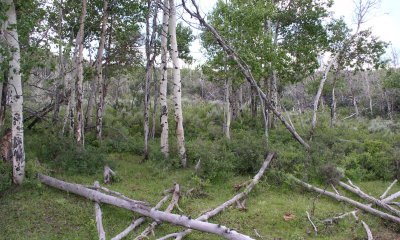
Upland Aspen Woodland Group
Scenario model
Current ecosystem state
Select a state
Management practices/drivers
Select a transition or restoration pathway
-
Transition T1-2
Fire suppression and frequent season long or severe grazing reduces aspen and encourages conifer encroachment.
More details -
Transition T1-3
Fire suppression and sever (frequent season long) grazing reduces the cloning and regeneration of aspen, reducing the community to a herbaceous community.
More details -
Transition T1-4
Improper (repeated severe) grazing and catastrophic fire with seed sources present transitions the site from Reference to the Invaded State.
More details -
Restoration pathway R2-1
Grazing management (rest rotation preferred) with removal of conifer growth is required to restore the state to Reference.
More details -
Restoration pathway R3-1
Grazing management with time provided for aspen regeneration allows this site to recover to the reference state.
More details -
No transition or restoration pathway between the selected states has been described
Target ecosystem state
Select a state
State 1
Reference: Aspen Stand









Description
Aspens serve as key habitat within the conifer forest ecosystem. Their ability to colonize on the landscape with a strong herbaceous under story serves as a forage source, shelter and aesthetic view point. This state is the reference state, with an Aspen dominated over story and a native, herbaceous under story.
Characteristics and indicators
The dominance of aspen trees in this community with a strong native under story and minimal composition of conifer species (less than 5 percent) are the signature characteristics of this State. This state does not provide for non-native species in the reference 1.1 community, but it is generally understood that it is difficult to find communities that have a zero composition of non-native invaders (Kentucky bluegrass, smooth brome, timothy).
Resilience management
Aspens are a delicate species, but overall are resilient and able to recover given time and management. Their ability to clone themselves, and rhizomatous nature assist in their perseverance on the landscape. however, they are susceptible to disease and insects which does inhibit them to some degree. Fire and grazing are both tools for management but also are an impact to this plant community
Submodel
State 2
Conifer Encroachment




Description
The Aspen canopy provides opportunity for conifer species to remain, especially those species that are somewhat shade tolerant. Subalpine fir is one of those species that can tolerate the shade within the aspen community and then thrive once the canopy deteriorates.
Characteristics and indicators
This state is identified by the loss of Aspen, with less than 10 percent remaining in the stand, and an increase in conifer species. The conifers can be a mix, but subalpine fir in upper elevations, engelman spruce in central elevations and Douglas-fir in lower elevations tend to be the dominant species encroaching in on this community/State.
Resilience management
This state is relatively resistant to change, but in the face of fire or following timber management to remove the unwanted conifer cover, the state will revert to a reference state with time and proper grazing management.
Submodel
Description
Deterioration of the Aspen community with age, disease, or over grazing by wildlife or livestock leads to the loss of the aspen under story as well as the herbaceous under story may be reduced to a select few species.
Characteristics and indicators
The Herbaceous State is characterized by the lack of Aspens in a community with a herbaceous under story. Remnant populations of old Aspens may still be present, but no young or producing Aspen are present in the community. The herbaceous is variable, but is generally limited to a few native grass/grass-like species and forbs.
Resilience management
Density of remaining herbaceous cover has proven to resist encroachment of other species, and serves to restrict the regeneration of Aspens, however with time and continued disturbance by grazing, logging or drought, this State becomes more susceptible to encroachment by conifer species or non-native species. Proper management and rest can help with transitioning this site back to reference.
Submodel
Description
The Invaded State for the Upland Aspen Woodland ecological site typically productive and maintain function for livestock forage and for habitat. The shift in herbaceous species can lower the quality of forage, but in some instances will make the system more resistant to change during drought, intensive grazing use, or other unforeseen impact. But there is a cost to the system as well in the loss of resiliency to these impacts.
Characteristics and indicators
Kentucky bluegrass and smooth brome are the two most dominant invaders across the scope of the ecolgoical site. Other invaders including thistle, houndstongue, and knapweed have been identified in these wooded sites. As the invaders increase, Aspen will decline in the community. There is debate on where the threshold for invasion occurs, whether it is at the first sign of any non-native species or if it occurs after a determined composition. This threshold should be taken on a by species basis, but to simplify for the case of this ecological site, if there is 10 percent or greater composition by cover, the ecological site is invaded.
Resilience management
Resiliency of this site is dependent on maintaining the health and quality of the native species, especially the aspens themselves, while striving to reduce or remove the invasive species. The aggressive nature and ability to compete for limited resources allows an invaded community to recovery after intense use, major disturbances including drought and fire (species dependent), or following logging.
Submodel
Mechanism
Fire suppression, especially with severe grazing by livestock and/or wildlife encourage the encroachment of conifer species. The pressure of the conifer species inhibits the cloning ability of aspen, and disease and insect impacts successfully decline or remove aspen from the community. Subalpine fir, Rocky mountain juniper, Douglas-fir, and white bark pine can be found in the over story.
Constraints to recovery
Removal of the conifer under story can be labor intensive or risky if fire is used depending on the location specifics. Once conifers are removed, reducing the risk of grazing impacts and browsing on young aspen saplings until the site is established and able to tolerate the use is key to allowing the site to recover.
Mechanism
Lack of fire and frequent, season long grazing (severe defoliation) by livestock and wildlife, the ability for aspen to clone or regenerate is reduced. Aspens are impacted by disease and insects more readily as they are stressed, and begin to decline in the over story. The herbaceous species in the under story will decline in diversity and become limited in number of species, but will maintain cover.
Constraints to recovery
The ability to reduce grazing impacts, especially by wildlife, can be difficult depending on the specific characteristics of a location. Once aspen has declined or been removed from the community, it can be challenging to invigorate regrowth of aspen. Providing time for recovery post fire, or limiting use of the the community until it has recovered is critical.
Mechanism
Repeated severe grazing without a period of recovery or during time when the community is fragile, especially with a seed source present, opens this community to invasive plant species. Catastrophic fire, especially in combination with drought, improper grazing, or other disturbance leads to an invaded community when the seed sources are present.
Constraints to recovery
The inability to reduce or remove most of the invasive species, specifically Kentucky bluegrass and smooth brome, without adversely impacting most native species limits the ability to recover this site. Without reducing the overall canopy of the herbaceous under story, Aspen have minimal chance of a full recovery, and the under story is currently thought to be irreversible.
Mechanism
Grazing management, with a rest rotation preferred, and removal of the conifer over story will allow aspen to recover on this site. Time for aspen recovery and targeted grazing to enhance the under story cover is needed to restore this community to the Reference State. Temporary exclusion from the community to allow aspen to regenerate may be necessary. The use of down fall or the conifer cuttings is one technique to limit access to allow aspen regrowth.
Relevant conservation practices
| Practice | External resources |
|---|---|
|
Prescribed Grazing |
|
|
Grazing Land Mechanical Treatment |
|
|
Upland Wildlife Habitat Management |
|
|
Livestock Use Area Protection |
|
|
Forest Land Management |
|
|
Patch-burning to enhance wildlife habitat |
|
|
Forest stand improvement for habitat and soil quality |
|
|
Wildlife corridors |
|
|
Forest stand improvement pre-treating vegetation and fuels |
|
|
Forest Stand Improvement to Reduce Wildfire Risk |
Mechanism
Grazing management with time allowed for aspen regeneration is key for the restoration of this site back to reference. Temporary exclusion from aspen community or the use of downfall to limit access by both livestock and wildlife is pertinent to allowing aspen to regenerate.
Relevant conservation practices
| Practice | External resources |
|---|---|
|
Prescribed Grazing |
|
|
Grazing Land Mechanical Treatment |
|
|
Heavy Use Area Protection |
|
|
Forest Stand Improvement |
|
|
Prescribed Grazing |
|
|
Grazing management to improve wildlife habitat |
|
|
Patch-burning to enhance wildlife habitat |
|
|
Forest stand improvement for habitat and soil quality |
|
|
Wildlife corridors |
Model keys
Briefcase
Add ecological sites and Major Land Resource Areas to your briefcase by clicking on the briefcase (![]() ) icon wherever it occurs. Drag and drop items to reorder. Cookies are used to store briefcase items between browsing sessions. Because of this, the number of items that can be added to your briefcase is limited, and briefcase items added on one device and browser cannot be accessed from another device or browser. Users who do not wish to place cookies on their devices should not use the briefcase tool. Briefcase cookies serve no other purpose than described here and are deleted whenever browsing history is cleared.
) icon wherever it occurs. Drag and drop items to reorder. Cookies are used to store briefcase items between browsing sessions. Because of this, the number of items that can be added to your briefcase is limited, and briefcase items added on one device and browser cannot be accessed from another device or browser. Users who do not wish to place cookies on their devices should not use the briefcase tool. Briefcase cookies serve no other purpose than described here and are deleted whenever browsing history is cleared.
Ecological sites
Major Land Resource Areas
The Ecosystem Dynamics Interpretive Tool is an information system framework developed by the USDA-ARS Jornada Experimental Range, USDA Natural Resources Conservation Service, and New Mexico State University.





